The days are growing longer and warmer weather is on its way. This means one thing: love is in the air! For birds at least. Spring means it’s nesting time for the majority of birds in our area. Birds are actively seeking out nesting sites to build nests, lay eggs and raise their young.
Some of the most common songbirds nest in bird houses. Bluebirds, chickadees, titmice, nuthatches, tree swallows, house sparrows, house finches and wrens all look for the safety of an enclosed house to raise their young. Woodpeckers, screech owls and wood ducks will also nest in houses, if the houses are big enough!
When selecting a bird house, it is important to look for specific features. First, and most importantly, make sure the bird house has a way to be cleaned out. Most of the time there is a small door in the back of the house that can be opened. This feature is made to clean out the old nest once the young have fledged, or “flown the coop”,. Some birds will have more than one brood a year and if they do, they will build a new nest. Cleaning out the bird house is important because it reduces the amount of mold and parasites that can otherwise accumulate in and under the nest. Also be sure to check your bird house for ventilation. Usually, there are small spaces in the upper or lower corners of the house that are cut out for air to flow. Having ventilation in the house also lowers the risk of mold building up in the house.
The size of the entrance hole of a house will dictate who can nest in it. The smaller the size of the hole, the more limited you are in what type of birds can fit in it. Wrens, for example, only need a house with an entrance hole of 1” in diameter. Chickadees only need a hole 1 1/8” in diameter. This size is also small enough to keep house sparrows out. Anything larger than 1 1/8” is big enough for them to fit through. If bluebirds are what you are after, get a nest box with a 1 ½” opening. To keep sparrows at bay, find a house that is sparrow-resistant. These often have innovative entry options or “sun-roofs” that discourage sparrows from nesting in them.
If your interest extends to even larger nesting birds, you might want to consider screech owls. Screech owls are a year-round resident of this area and when full grown are less than 10” tall. Many people have luck with attracting screech owls to their yards with a screech owl nesting box. These houses have a 2” diameter and should be placed at least 10 feet high.

Sparrow in bird house. Photo courtesy Flickr: the1pony
When mounting a bird house, remember that most birds like their house to be secure. If it is moving around in the wind, many birds will not nest in it. Wrens, house sparrows, and chickadees will nest in houses that are hanging, but many other species will not. Bird houses should be mounted at least 5 feet off the ground in order to keep them protected from predators like cats who can catch birds mid-air. Baffles can be mounted on a bird house pole to keep squirrels and raccoons from climbing up the pole to raid the box of the eggs or young inside it. Bird house “guardians”, tubular extensions to bird house entrances, are another item that will keep squirrels and raccoons from reaching inside the nest box.
Keep in mind that not all birds will nest in a house. Robins, cardinals, mourning doves and barn swallows will nest on nesting perches, a semi-enclosed platform that shields them from the elements and provides protection. Hummingbirds, orioles and goldfinches build their nests in trees and can be enticed to nest in your yard by offering a nesting ball full of natural cotton and string. Scraps of yarn, pet hair, and feathers can be left outside for birds to use as nesting material, but do not use dryer lint, as the chemicals in it that are used to launder clothes can be harmful to birds.
Finally, it is worth remembering that caring for our feathered friends is often as much an art as it is a science, and that results will vary. Have faith, have fun, and use the advice in this article to give yourself a great start. And most importantly, don’t forget that love really is in the air, so now is the perfect time to be a match-maker by putting out your bird houses, cleaning out your old ones, and maintain a steady watch for all the little (and not so little) ones that will call them home!
Liz Magnanti is the manager of the Bird House on Monroe Avenue in Pittsford. She has a degree in wildlife conservation and has worked as a naturalist at various nature centers.
Views: 0






